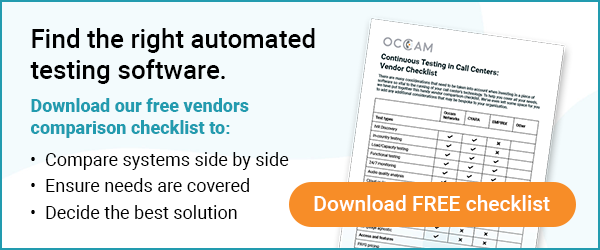As your business grows, so does your call center’s incoming calls. How can you be sure your infrastructure is going to be able to take the strain? By creating a robust stress test schedule, you can have the peace of mind that your technology will be up to the job.
Get Proactive
Stress testing is a vital exercise that all call centers must practice in order to detect and prevent issues before they directly affect your customers. By running stress tests regularly, and with plenty of time before seasonal peaks, such as Black Friday for retailers, your tech team will be able to improve and optimize any areas of the call center infrastructure that could be at risk of crashing under pressure.
To have a true picture of your call center’s agility, you should be continuously testing the full customer journey in its entirety. Every time a new feature or change is rolled out to your system – no matter how small – it should be tested to avoid any customer getting stuck in a loop or transferred to a dead end. If you decide to skip this, you not only run the risk of losing a customer but also damaging the reputation of the business through your level of customer service.
What to test
When creating your stress testing process, you will want to start with the most common customer journeys so that any issues you discover can be prioritized accordingly.
Areas to consider:
- Inbound and outbound interactions to and from the agents
- Agent’s interactions with the technology in place
- All the available methods of communications a customer could use to get in touch with an agent (phone, SMS, LiveChat, etc.)
- How calls are routed to appropriate agents
- Deployment of any new features within the call center
Metrics to measure:
- Total number of agents that would be logged in at the same time
- Number of outbound calls generated
- Number of inbound calls received
- The rate an agent will go online to attend a call
- Average number of simultaneous calls to be handled by agents each hour
- The number of emails generated and received
- Average number of emails handled by an agent each hour
Remember, the general assumption of a customer is that your company has a flawless contact center that will solve their problems with ease. When calling to resolve an issue, a customer’s tolerance for error is likely to be significantly low; it is, therefore, essential to make their experience as smooth as possible to relieve any potential pressure that may be put on the human agent that has to eventually handle the escalation.
Automate
The reason that many call centers shy away from load testing is due to the worry that these tests could interfere with real customers getting through to agents and so the workaround becomes a nightmare for the tech team resulting in late-night testing to avoid any hiccups during office hours.
But what if there was a better way?
A continual testing platform can automate these tests for you by initiating multiple, simultaneous calls at defined times, replicating the projected volume of calls your center expects to process, allowing you to monitor and report on the performance of the live environment in a matter of minutes.
With these automated tests, you can gather real data into the customer experience you offer. For example, if your contact center is running at 60% capacity, using a platform such as Occam's Experience Testing System (ETS), you will be able to push the capacity up to see how your system will perform and determine the risk to your customers may experience.
Traditional automated testing solutions used to rely heavily on a third party professional service to build and carry out any automated testing scenarios, which is not only costly and time-consuming but also inhibits your ability to deploy changes to your system or work to a DevOps methodology.
Occam’s ETS system has been designed to automatically provide an interactive mapping of your IVR environment and highlight any potential errors to allow you to check the current performance. You can also easily build your test scenarios from the information within ETS rather than manually uploading or importing scripts and audio files, allowing you to manage any load testing internally and the flexibility to run the tests as often as you need.




